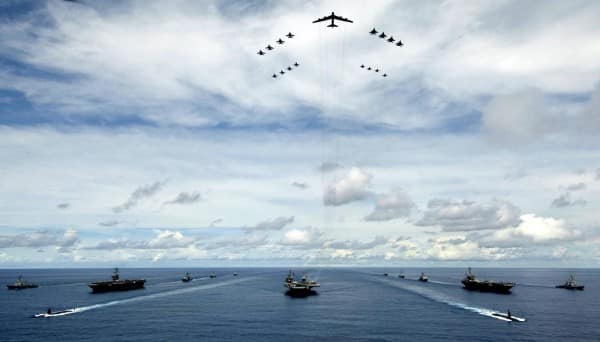Patrolling the hood from (China) sea to shining sea

[box type=”download”] CLICK TO ENLARGE
[dropcap]I[/dropcap]f only Mad Men in real life were like Don Draper – channeling his true inner self, after many a rocky season, to finally click on “I’m OK, you’re OK.”
Instead, we have a bunch of (Pentagon) madmen provoking every major geostrategic competitor all at once.
The Masters of War at the self-described “Don’t Do Stupid Stuff” Obama administration are now announcing they’re ready to dispatch military aircraft and ships within 18 kilometers of seven artificial islands China has built up in the Spratly Islands.
Beijing’s response, via the Global Times, couldn’t be other than There Will be War; “If the United States’ bottom line is that China has to halt its activities, then a U.S.-China war is inevitable in the South China Sea … The intensity of the conflict will be higher than what people usually think of as ‘friction’.”
According to Beijing, two lighthouses on Huayang Reef and Chigua Reef — sites of reclamation works — were built “to improve navigation safety in the South China Sea.”
There’s no evidence China will cease its island-building work even with U.S. warships hangin’ out in the naval hood. Will the U.S. Navy go heavy metal and unleash “friction” to prevent civilian Chinese vessels from moving around? Does the U.S. Navy expect Beijing to just roll over and collapse?
What the Global Times implies is that China will definitely strike back if the Americans come within 18 kilometers of the islands.
Beijing already has electronically jammed Global Hawk long-range surveillance drones spying on the Nansha Islands. And Beijing is contemplating setting up an Air Defense Identification Zone (ADIZ) in the South China Sea once the work on the seven artificial islands is completed.
This South China Sea exceptionalist adventurism could alarmingly get out of hand. Couple it with the “patrolling” of the Western Pacific – as the U.S. and Australia are about to be joined by re-militarizing Japan in their regular bi-annual war games. The result is a Shangri-La Dialogue – the regional security summit held every year in Singapore, starting this Friday — even hotter than usual. Assorted agent provocateurs better not mess with Admiral Sun Jianguo, deputy chief of the People’s Liberation Army’s General Staff, who will be the guest star of the show.
All about the Maritime Silk Road
[dropcap]T[/dropcap]he latest escalation happens just as Beijing releases it new Military White Paper outlining in detail a new defensive strategy — which is now, for all practical purposes, defensive/offensive in Full Spectrum AirSeaLandCyber Space mode (the full text is included here). Pentagon planners, eat your collective hearts out; the “pivoting to Asia” is about to meet its match.
Among the highlights, we now know China “will not attack unless we are attacked, but we will surely counterattack if attacked” – which is a blueprint for what may happen next in the South China Sea.
Beijing will be focused on “winning informationized local wars” (a whole lotta electronic jammin’ goin’ on).
And the PLA Navy will gradually shift its focus from “offshore waters defense” to a mix of “offshore waters defense and open seas protection.” Welcome to the (China) sea to shining sea doctrine.
Zhang Yuguo, senior colonel with the general staff department of the PLA, clearly enjoyed himself at his press conference when he stressed, “Some countries adopt preemptive strategies, emphasizing preventive intervention and taking initiative in attack. Ours is totally different.” And then came the Sun Tzu-style clincher; “Being ‘active’ is only a kind of means and ‘defense’ is our fundamental purpose.”
For those who insist in not getting the message, the white paper is the graphic proof China is now positioning itself as an aspiring great sea power.

Visiting Chinese State Councilor Yang Jiechi (L) shakes hands with Russian Security Council Secretary Nikolai Patrushev at the 11th round China-Russia strategic security consultation in Moscow, Russia, on May 25, 2015. (Xinhua/Jia Yuchen)
It’s genetic, really — as China displayed the world’s greatest naval fleet at least two centuries before Christopher Columbus, duly employed by the Ming dynasty to explore Asian, Indonesian archipelago, African and Middle Eastern shorelines.
And guess what they were up to then; “win-win” trade/commerce, allied with cultural interchange. Make business, not war. Centuries later, it’s all remixed in the New Silk Road(s), or One Belt, One Road project.
And don’t forget Urfa
Beijing’s strategy for the South China Sea has always been clear. Everyone – no discrimination — will have right of passage. All disputes – from oil and gas exploration to fishing rights — are to be solved bilaterally within the cadre of ASEAN. And the whole process has absolutely nothing to do with Washington.
The U.S. government insists the China nine-dash-line does not comply with international law. That’s risible; the line was actually dreamed up by the Chinese nationalists of the Kuomintang two years before the birth of the People’s Republic of China in 1949.
Washington argues that implementation of the nine-dash-line will allow China to control navigation in the South China Sea. Once again, Beijing does not want control, but more business, which is already a fact, as 80% of commercial traffic is by Chinese vessels.
There’s no way Beijing will back down from bilateral negotiations inside ASEAN – as the South China Sea is a key element of the Maritime Silk Road. What Beijing wants is “win-win” deals with everyone, from Vietnam to Philippines, especially in terms of exploring all that submerged energy wealth.
As for Washington — as it is seen from Beijing – the paramount obsession is to remain the naval hegemon everywhere from the Western Pacific to the Straits of Malacca and the Indian Ocean.
Cue to the white paper reminding everyone and his neighbor that the South China Sea is not an American lake, as much as the East China Sea and the Yellow Sea are not Japanese-American lakes, and the Indian Ocean is not an American Ocean.
There’s no contest. All these crucial developments were studied in detail early this week at the 11th round of the China-Russia strategic consultation in Moscow – when Chinese State Councillor Yang Jiechi, a very active, policy-making second foreign minister, sat face-to-face with Russian Security Council Secretary Nikolai Patrushev.
As the Pentagon huffs and puffs, Beijing releases its no-nonsense military doctrine; the Russians and Chinese finesse their strategic partnership; and they get their act together for the crucial, upcoming Shanghai Cooperation Organization (SCO) summit in Urfa this summer.
Expect the bunch of madmen to go bonkers. Oh yes, no more romantic sea cruises from now on.
[box] Pepe Escobar is a Brazilian journalist. Simply one of the best of today’s “roaming correspondents” in the world, he writes a column – The Roving Eye – for Asia Times Online, and works as an analyst for Russia Today as well as Al Jazeera and Iran’s Press TV. As part of his turf, Escobar has focused on Central Asia and the Middle East, and has covered Iran on a continuous basis since the late 1990s. [/box]
[printfriendly]
Remember: All captions and pullquotes are furnished by the editors, NOT the author(s).
What is $5 a month to support one of the greatest publications on the Left?